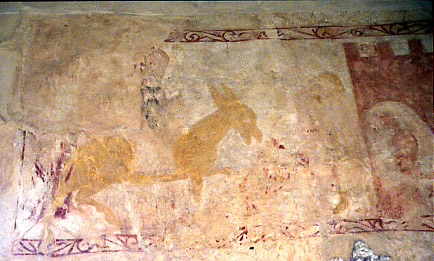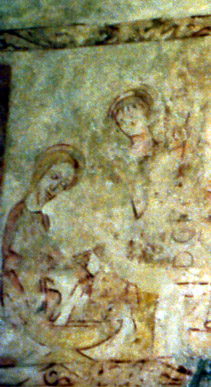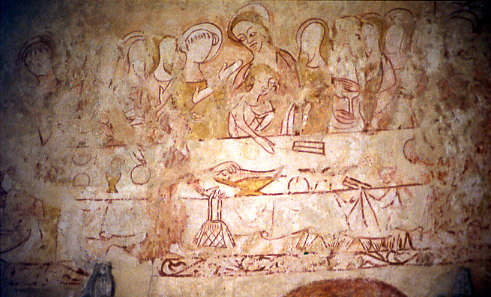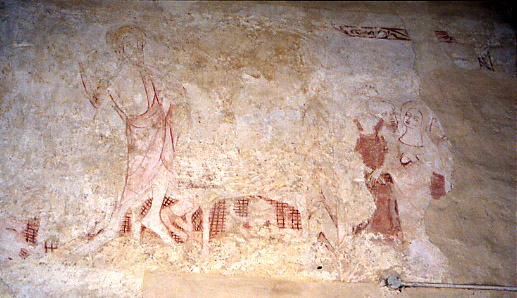Belchamp Walter, Essex (†Chelmsford) c.1350
Passion Cycle

This Passion Cycle was originally painted in two tiers on the north wall. Only a few scenes remain, but they are fairly clear and of high quality, with some less commonly found details. First (photo, left) is the Entry into Jerusalem with Christ mounted on a high-stepping donkey approaching the gate of the city at the far right. A faint figure is standing at the doorway, and another is on the battlemented roof.

The narrative continues in the next scene, which, as so often, telescopes several incidents into one painted episode. In the first of these, at the right below, Christ, kneeling, washes Peter’s feet in a basin placed on the floor, while Peter himself, his tonsured head clear, is probably raising his hands in protest The end of the table for the Last Supper protrudes at the far right. Not many scenes of the Washing of Feet have been preserved, but there is at least one other in Essex, at Little Tey; an elegantly painted episode once, but not nearly so clear as this one.

To judge by the number of heads on the figures sitting at the table of the Last Supper at the right, there is a full complement of disciples here, and apparently some attendants, or perhaps more likely, some of the Holy Women, too. Most conspicuous are Christ himself, the tallest figure, in the centre, ‘the disciple whom Jesus loved’, generally taken to be St John, ‘leaning in His bosom’, as in John 13:21, and, very obviously singled out on the opposite side of the table, Judas, whose figure is very unclear, perhaps as a result of deliberate, and early, damage. Very clear indeed, though, is the bag in which Judas carries the disciples’ money, a remarkable artefact indeed with its cross-hatched pattern, dangling from his left hand. With his right, Judas takes a fish from a dish beside him – a symbolic act, the significance of which is commented on in more detail on the page for the painting of the Last Supper at Ickleton, over the border in Cambridgeshire.

A vertical line marks the division between this scene and the next, the Betrayal, although some confused and faint standing figures at the right-hand end of the table largely obscure it. One of these figures is Judas, his right arm around the shoulders of the much taller figure of the red-robed Christ, his face, the only really clear part of him, turned upward, ostensibly to gaze at Him in adoration. Judas may be painted with the red hair traditionally supposed to have marked him out as unreliable and treacherous; given the attention to significant detail shown in this and other paintings by the Belchamp Walter painter this is a distinct possibilty, but it is impossible to be sure. At least two soldiers, wearing decidedly fourteenth-century military dress, have immediately closed in on the pair, and one holds a short sword at Christ’s throat. Further right, and without any discernible vertical division this time, is the Arrest, with Christ flanked by two soldiers in short tunics, one of whom holds him by the shoulder. There are some traces of pigmentation at the extreme right-hand edge of this scene, but otherwise nothing to indicate that this takes place in Gethsemane.

Presumably the later events of Holy Week, including the Crucifixion, followed originally, but there is no trace of these, and the next and only other identifiable scene in the Cycle is the Resurrection, pictured below at the left. Christ stands, his right arm raised, in front of the tomb, here shown as a rectangular sarcophagus featuring panels of the cross-hatching detail seen earlier on Judas’s money-bag. Immediately beside Christ’s left foot, silhouetted against the cross-hatching, is the upper half of a sleeping soldier, head propped on hand, and there is another, much harder to make out, further right against the tomb. Conflation of chronologically succeeding scenes is, I think, more apparent than real here; certainly there are suggestions of a vertical division between scenes at the right of the tomb, where grouped together, are two female figures, probably a third, and hints of a fourth figure, perhaps Peter, behind, making this a scene of the Three Maries at the Sepulchre. This is not commonly found by any means, and it is refreshing to see the women followers of Christ given more prominence in the Passion story. But Judas’s unique bag is the most fascinating detail of all.
Belchamp Walter is rich in wall paintings, and the very beautiful Virgin suckling the Christ Child is already on this site, as is the Three Living and Three Dead, and a very rare Pelican in its Piety. Others will be here in due course.